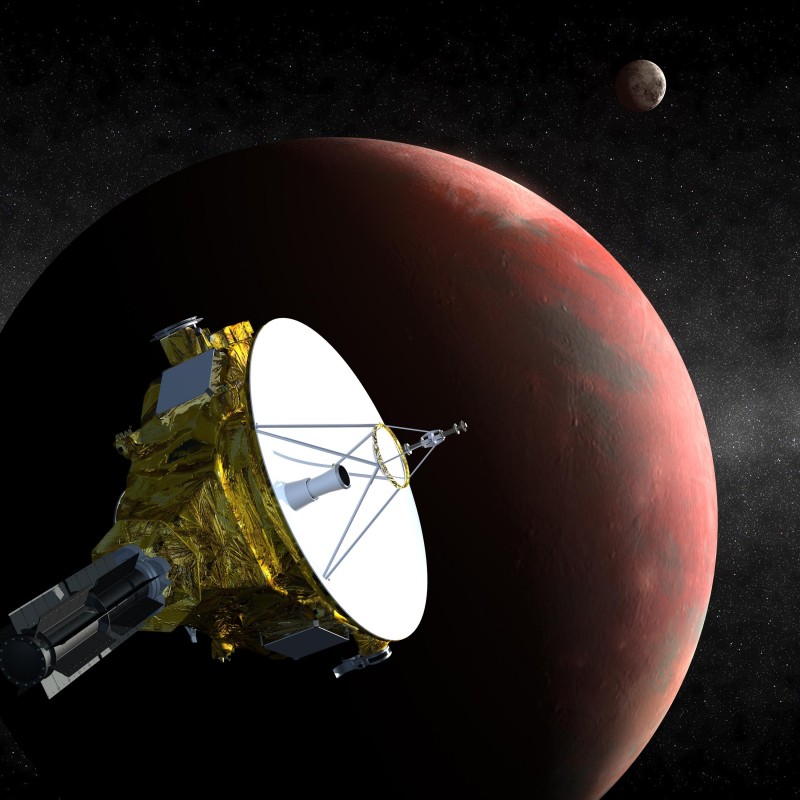NASA says its New Horizons spacecraft will complete a historic flyby of Pluto on Tuesday, making its closest pass over the small, icy world at 7:49 a.m. ET.
The unmanned, piano-sized spacecraft will be traveling nearly 31,000 miles per hour when it passes about 7,750 miles over Pluto.
It’s the first mission to Pluto and its five moons.
Because the spacecraft will be busy gathering data during the flyby, it won’t phone home to update its status until Tuesday around 9 p.m. ET.
“That’s going to be a very highly anticipated event,” Alan Stern, the mission’s principal investigator said at a briefing Monday.
The wait will be a tense one.
“There’s that small element of danger so I think we’re all going to breathe the final sigh of relief at 9 p.m. and that’s when we can really call it a successful flyby,” Stern said.
When will you see photos from the flyby? It takes four hours for the probe to get a signal back to Earth and then NASA has to process the data. Mission managers expect the images from the close encounter to be released on Wednesday at 3 p.m. ET online and on NASA TV.
Scientists on Monday said New Horizons already has settled one debate about Pluto — it’s size. Information gathered by the probe indicates Pluto is 1,473 miles (2,370 kilometers) in diameter. That’s somewhat bigger than earlier estimates and it means Pluto is larger than all other known solar system objects beyond the orbit of Neptune.
The probe already has beamed back several crisp photos of Pluto and its largest moon Charon.
“Pluto and Charon are both mindblowing,” Stern told CNN on Saturday. “I think that the biggest surprise is the complexity we’re seeing in both objects.”
The mission completes what NASA calls the reconnaissance of the classical solar system, and it makes the U.S. the first nation to send a space probe to every planet from Mercury to Pluto. The probe traveled more than 3 billion miles to reach Pluto.
Why go to Pluto?
New Horizon’s core science mission is to map the surfaces of Pluto and Charon. It also will study their atmosphere.
The spacecraft was launched on January 19, 2006, before the big debate started over Pluto’s status as a planet. In August of that same year, the International Astronomical Union reclassified Pluto as a dwarf planet.
But Stern disagrees with the IAU’s decision.
“We’re just learning that a lot of planets are small planets, and we didn’t know that before,” Stern said earlier. “Fact is, in planetary science, objects such as Pluto and the other dwarf planets in the Kuiper Belt are considered planets and called planets in everyday discourse in scientific meetings.”
New Horizons has seven instruments on board to help scientists better understand how Pluto and its moons fit in with the rest of the planets in our solar system.
The planets closest to our sun — Mercury, Venus, Earth and Mars — are rocky. Jupiter, Saturn, Uranus and Neptune are gas giants. But Pluto is different: Even though it is out beyond the gas giants, it has a solid, icy surface.
Beyond Pluto
New Horizons looks like a gold foil-covered grand piano. It’s is 27 inches (0.7 meters) tall, 83 inches (2.1 meters) long and 108 inches (2.7 meters) wide. It weighed 1,054 pounds (478 kilograms) at launch.
The probe won’t orbit Pluto and it won’t land. Instead, it will keep flying, heading deeper into the Kuiper Belt, a region that scientists think is filled with hundreds of small, icy objects.
“The universe has a lot more variety than we thought about, and that’s wonderful,” Stern said. “The most exciting discoveries will likely be the ones we don’t anticipate.”
Stern said mission managers will decide later this year where to point New Horizons for the next part of its journey.
